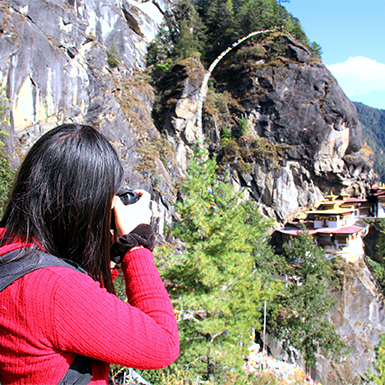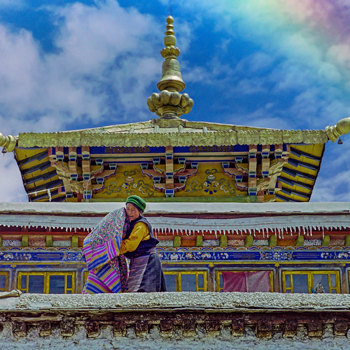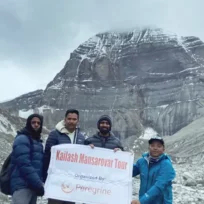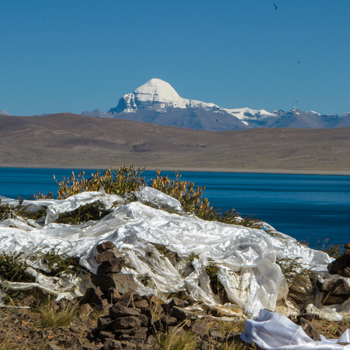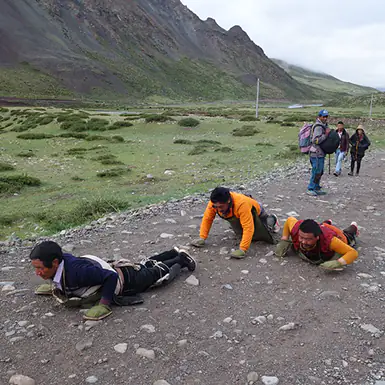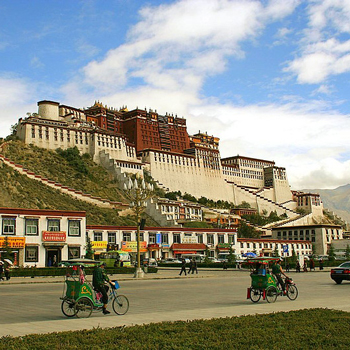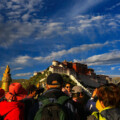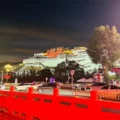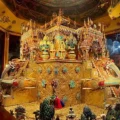Tibet, the “Roof of the World,” beckons travelers with its breathtaking landscapes, rich cultural heritage, and spiritual significance. Mount Everest, the world’s tallest peak, is adorned with numerous monasteries and vibrant prayer flags, offering a journey like no other. However, because of its high altitude and remote location, careful planning is crucial before starting a trip to Tibet. This Traveling to Tibet guide equips you with the essential knowledge to navigate your adventure. We’ll delve into the must-know aspects of traveling to Tibet, ensuring a smooth and enriching experience.
A Glimpse into the Land of the Snows
Tibet, an autonomous region of China, boasts unparalleled natural beauty. Towering snow-capped mountains pierce the azure sky, vast grasslands unfurl as far as the eye can see, and turquoise glacial lakes reflect the grandeur of the surrounding peaks.
Culturally, Tibet is a tapestry woven with ancient traditions and profound spirituality. Vibrant prayer flags flutter in the wind, echoing the chants of monks within magnificent monasteries.
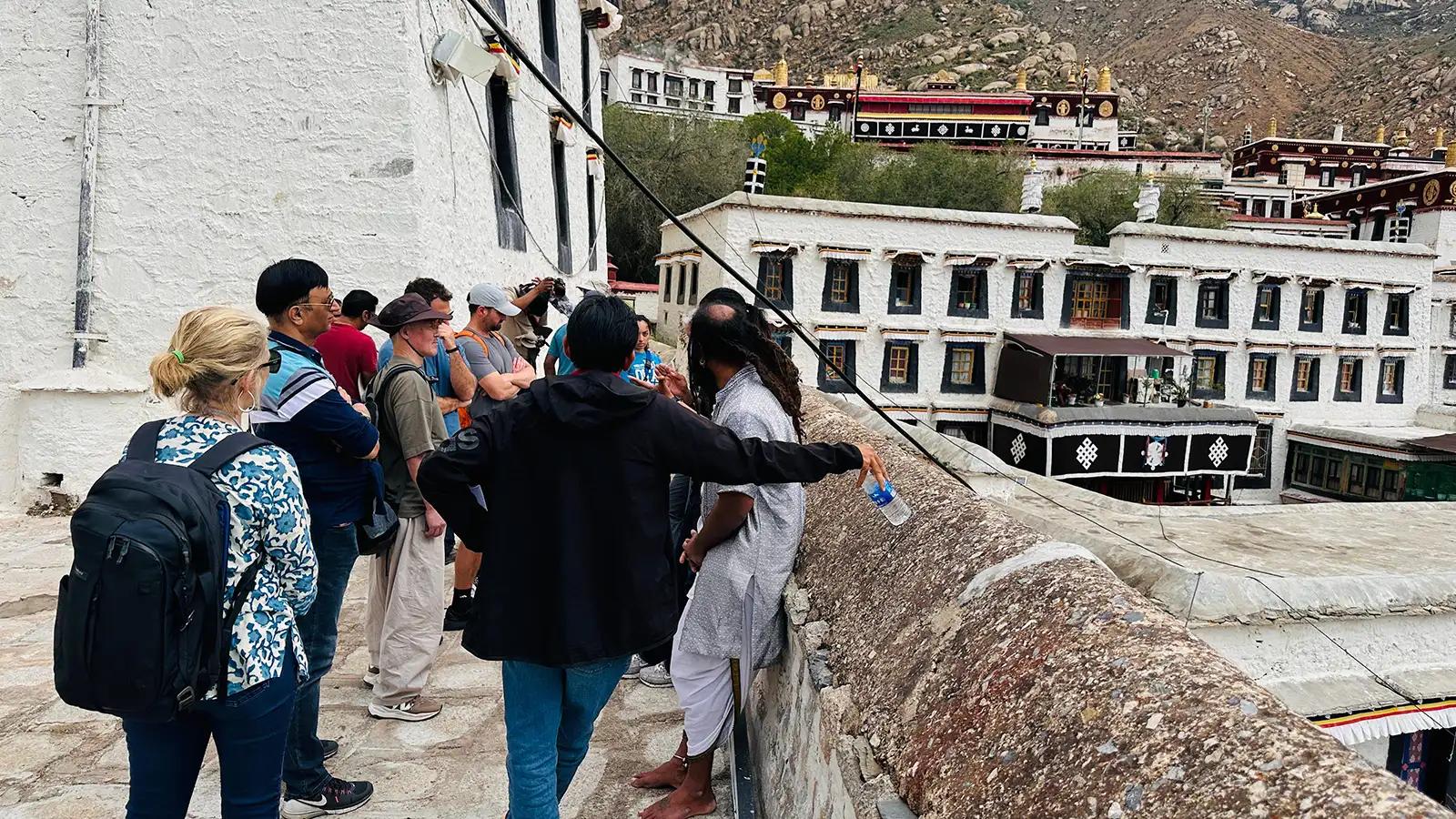
1. Demystifying Permits and Visas: Your Gateway to Traveling to Tibet
Obtaining the necessary permits and visas is crucial before traveling to Tibet. Don’t worry; this section unravels the process, ensuring a smooth entry into the “Land of the Snows.”
The Chinese Visa: Your Entry Ticket to China
Most travelers require a Chinese visa to enter China, which can be obtained from a Chinese embassy or consulate in your home country. The type of visa you need depends on your nationality and the duration of the trip. Trips to Tibet typically require a tourist visa (L visa). Gather the necessary documents, such as your passport, visa application form, and proof of travel and accommodation, and submit them well in advance, as processing times can vary.
The Tibet Travel Permit: Your Pass to Explore Tibet
You will need more than a Chinese visa to get access to Tibet. You’ll also need a Tibet Travel Permit, a special entry permit issued by the Tibet Tourism Bureau. Here’s what you need to know:
- Obtaining the Permit: Foreign tourists can only apply indirectly. Instead, you must book a tour with a licensed travel agency in Tibet or Nepal, such as Peregrine Treks and Tours. Tours to Tibet typically include assistance with obtaining the permit.
- Required Documents: You need a photocopy of your passport, visa copy, and itinerary details. Processing times can take up to 15 business days, so plan accordingly.
- Restrictions: The permit is specific to your itinerary, including destinations and travel dates. Changing your trip after obtaining the permit can take time and effort.
Venturing Further: Permits for Restricted Areas
Some areas in Tibet, like Mount Everest Base Camp or Mount Kailash, require additional permits due to their remoteness or cultural significance. We obtain these permits along with the Tibet Travel Permit.
Remember: By understanding these visa and permit requirements, you can easily navigate the administrative aspects of traveling to Tibet. Now, let’s explore what to pack for your adventure!
2. Unveiling the Perfect Time: When to Visit Tibet
Tibet’s captivating beauty unfolds throughout the year. However, the best time for your visit varies based on your preferences. This section sheds light on Tibet’s climate and weather patterns, guiding you toward the season that best suits your dream trip to Tibet.
Understanding Tibet’s Climate
Tibet’s high altitude (average elevation exceeding 4,500 meters) translates to a unique climate. Here’s a quick breakdown:
- Generally dry: Tibet experiences low rainfall year-round.
- Thin air: The high altitude reduces oxygen levels, so acclimatization is essential.
- Significant temperature variations: Days can be warm and sunny, while nights are cold.
Seasons to Savor: Choosing the Perfect Time
June to October emerges as the prime window for most travelers. Let’s explore why:
- Pleasant weather: Spring (April-May) and autumn (September-October) boast sunshine, clear skies, and comfortable temperatures, ideal for sightseeing.
- Minimal rainfall: The monsoon season is less pronounced in Tibet than in neighboring regions.
- Clear skies: These months offer the best chance of witnessing breathtaking mountain panoramas.
Spring (April-May)
- Pros: Pleasant temperatures and fewer crowds than peak season (July-August).
- Cons: Some high-altitude areas might still be inaccessible due to snow.
Summer (June-August)
- Pros: Warmest temperatures, ideal for trekking and outdoor activities.
- Cons: The highest chance of rain (though minimal compared to other regions) and the most crowded time to visit.
Autumn (September-October)
- Pros: Stunning fall foliage, comfortable temperatures, clear skies.
- Cons: Temperatures start to dip, and some high-altitude areas might close again.
Winter (November-February)
- Pros: Dramatic snowy landscapes, fewer crowds, and a chance to witness unique Tibetan festivals.
- Cons: Frigid temperatures, many roads and attractions closed.
Festival Fun: Adding Spice to Your Trip
Tibet comes alive with vibrant festivals throughout the year. Consider aligning your trip with these celebrations to experience Tibetan culture firsthand:
- Shoton Festival (July/August): A lively yogurt festival with traditional performances.
- Garma Gyecé Festival (Horse Racing Festival) (July/August): A thrilling horseback riding competition.
- Tibetan New Year (February/March): A festive time marked by prayer ceremonies and traditional dances.
Remember: Trips to Tibet during peak season (July-August) offer pleasant weather but attract larger crowds. Consider shoulder seasons (April-May, September-October) for a good balance between weather and crowds.
By understanding Tibet’s climate and seasonal highlights, you can select the optimal time to experience the enchantment of the “Roof of the World.” Now, let’s explore what to pack for your unforgettable adventure!
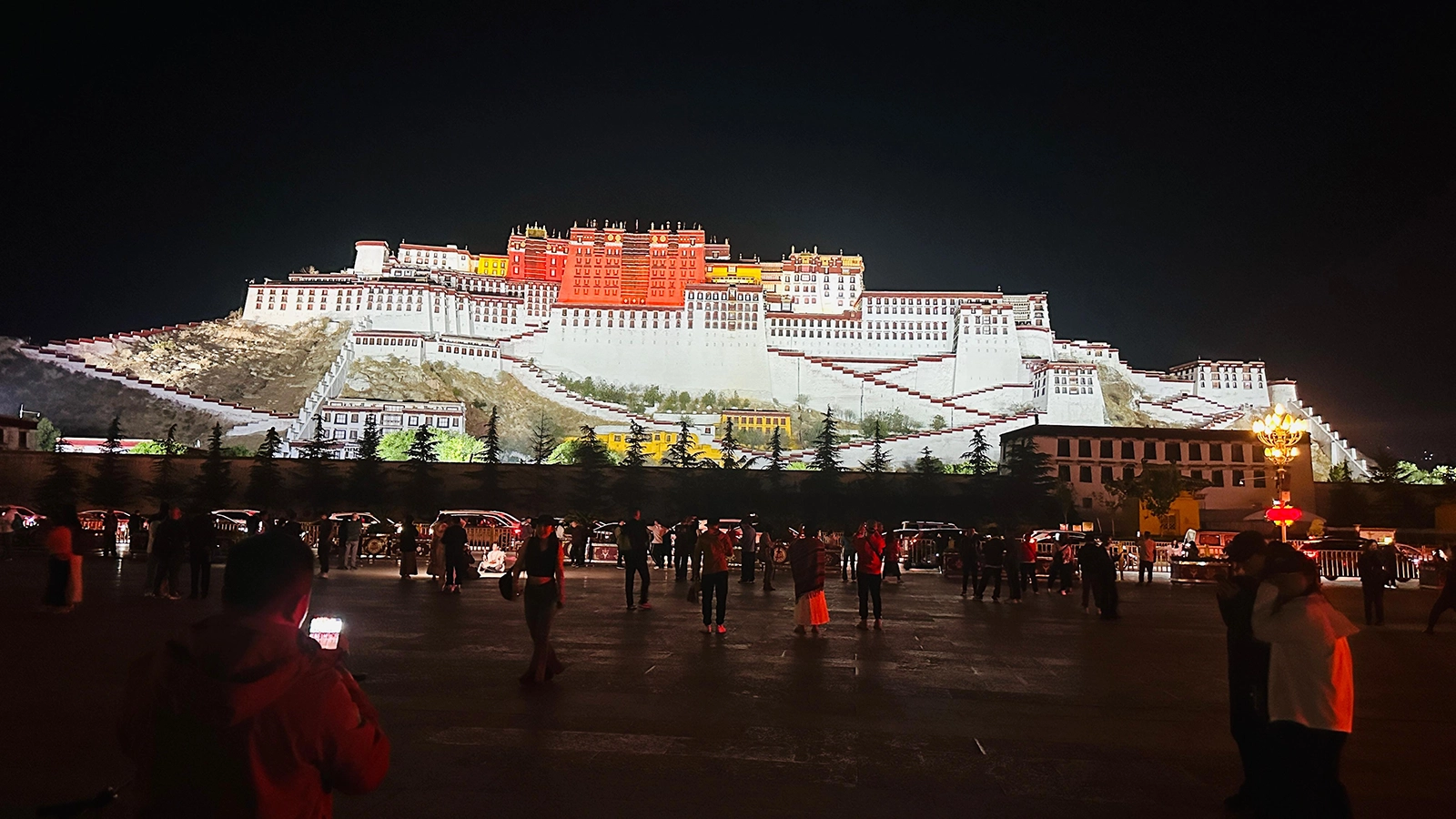
3. Conquering the Roof of the World Safely: Health and Precautions for Traveling to Tibet
The majestic landscapes of Tibet beckon, but its high altitude demands careful planning to ensure a safe and enjoyable trip. This section equips you with essential health and safety knowledge for your Tibet adventure.
Acclimatization: The Key to Conquering Altitude
Tibet’s high altitude, with an average elevation exceeding 4,500 meters, means less oxygen in the air. This can lead to altitude sickness, causing headaches, nausea, and fatigue. Acclimatization is crucial. Here’s how to approach it:
- Gradual Ascent: Plan your itinerary to gain altitude gradually. Consider adjusting for a few days in Lhasa (3,656 meters) before venturing higher.
- Listen to Your Body: Ascend slowly and avoid strenuous activity for the first few days. Take breaks often and rest whenever you feel tired.
- Hydration is Key: Drink plenty of bottled water to stay hydrated, even when thirsty. Dehydration worsens altitude sickness.
Preventing Altitude Sickness: Taking Precautions
While acclimatization is essential, some additional steps can minimize your risk of altitude sickness:
- Consult Your Doctor: If you have any existing health conditions, consult a doctor. They might advise medication to help with altitude sickness.
- Pack Wisely: Bring medications for common ailments like headaches, nausea, and diarrhea.
Vaccinations and General Health
- Recommended Vaccinations: Consult your doctor to ensure you’re up-to-date on routine vaccinations. Hepatitis A and rabies are commonly recommended for travel to Tibet.
- Sun Protection: The intense UV rays at high altitudes can be harsh. Pack sunscreen (SPF 50+), sunglasses, and a hat.
- Hygiene Practices: Be mindful of hygiene, especially food and water consumption, to avoid stomach upset.
Medical Facilities in Tibet
Medical facilities in Tibet, particularly in remote areas, might be limited. Here’s what to keep in mind:
- Basic Medical Care: Most towns have basic medical facilities.
- Serious Medical Issues: If you have serious medical issues, evacuation to a larger city with advanced medical care might be necessary.
- Travel Insurance: It is mandatory to do a tour with Peregrine, and it must cover your medical emergencies and evacuation.
By prioritizing your health and taking these precautions, you will feel safe and have an unforgettable trip to Tibet. Next, we’ll explore what to pack for your adventure!
4. Packing Smart for the Roof of the World: Essentials for Traveling to Tibet
A successful trip to Tibet hinges on careful planning, and packing is no exception. Here’s a comprehensive list of essentials to ensure you’re prepared for the unique weather conditions and cultural experiences that await:
Conquering the Elements: Clothing and Gear
- Layers are Key: Tibet’s weather can be unpredictable. Pack thermals, fleece jackets, a waterproof outer layer, and a warm-down jacket for colder nights.
- Sun Protection: Don’t underestimate the intense UV rays at high altitudes. Pack sunscreen, sunglasses, a wide-brimmed hat, and lip balm with SPF.
- Footwear Matters: Comfortable hiking boots with good ankle support are essential for exploring uneven terrain. Pack sandals or flip-flops for evenings.
- Quick-Drying Clothes: These are ideal for day trips and activities, as laundry options might be limited.
Essential Documents: Traveling to Tibet
- Passport and Visas: You must have blank visa pages for six months’ valid passport from your travel dates. Secure a Chinese visa and a Tibet Travel Permit (obtained through your travel agency).
- Travel Documents: Passport copies, visa, permit, travel insurance, and flight bookings are readily available.
- Photocopies: Bring photocopies of your passport ID page and visa for emergencies or permit checks.
Staying Healthy: Packing for Well-being
- Altitude Sickness Medication: Talk with your doctor about medications like Diamox to help with altitude acclimatization.
- Basic First-Aid Kit: Pack essentials like pain relievers, bandages, anti-diarrheal medication, and antiseptic wipes.
- Personal Hygiene: Wet wipes, hand sanitizer, and toiletries are crucial, as some facilities might have limited supplies.
- Water Purification Tablets or Portable Water Filters: While bottled water is recommended, these can be helpful for emergencies.
Remember: Trips to Tibet often involve monastery visits, so pack modest clothing that covers shoulders and knees. Check baggage restrictions with your airline and tour operator beforehand.
You can confidently navigate Tibet’s diverse landscapes and cultural encounters by packing wisely. Now, explore some valuable tips for navigating cultural etiquette and maximizing your experience!
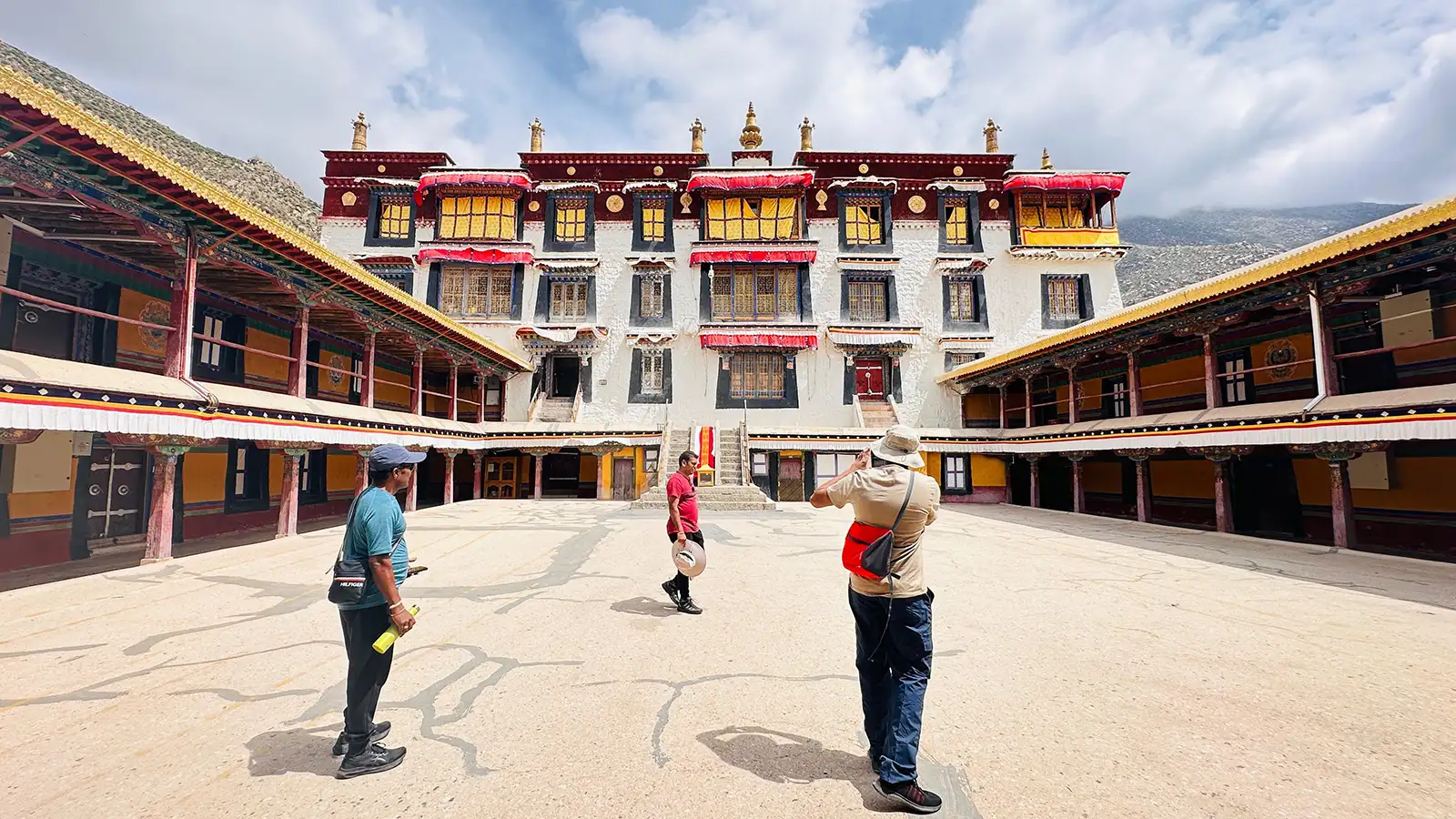
5. Unveiling Tibetan Hospitality: A Guide to Cultural Etiquette
Tibet’s rich culture extends beyond its breathtaking landscapes. Traveling to Tibet allows you to experience a unique way of life. Understanding and respecting local customs is essential for a smooth and enriching experience.
A Glimpse into Tibetan Traditions
Tibetan culture is deeply rooted in Buddhism. Prayer flags fluttering in the wind, monks chanting in monasteries, and reverence for the natural world are all integral aspects of Tibetan life. Here are some key things to remember:
- Respect Religious Sites: Monasteries and temples are sacred spaces. Dress modestly, speak softly, and avoid pointing your feet toward religious objects.
- Greetings and Courtesy: A respectful nod or a slight bow is a standard greeting. Avoid handshakes unless offered first.
- Public Displays of Affection: Public displays of affection are not customary in Tibetan culture.’
Do’s and Don’ts for Respectful Interaction
- Do: You have to ask permission before taking photographs of people, especially monks or religious figures.
- Don’t Point the soles of your feet towards people or religious objects, as it’s considered disrespectful.
- Do: Offer and receive items with two hands as a sign of respect.
- Don’t: Haggle excessively in shops. Fair prices are usually offered.
- Do: Be patient and understanding. Communication styles differ, and things move at a slower pace.
Dressing for the Occasion: Modesty Matters
- Monasteries and Temples: Dress modestly, covering shoulders and knees. Avoid revealing clothing or hats inside religious sites.
- Rural Areas: Dress conservatively, especially in villages. Opt for long pants or skirts and avoid overly revealing clothing.
- Cities: Lhasa and other larger towns offer more relaxed dress codes. However, modesty is still appreciated, so avoid overly revealing outfits.
Remember: Trips to Tibet are often deeply cultural experiences. With due respect for local customs and traditions, you can ensure a positive and enriching interaction with the Tibetan people. In the next section, we’ll explore some valuable tips for navigating your trip and maximizing your time in Tibet.
6. Resting Your Body and Savoring Flavors: Accommodation and Food Options for Traveling to Tibet
Traveling to Tibet offers a unique blend of adventure and cultural immersion. This section explores your accommodation and food options, ensuring a comfortable and delicious experience.
Finding Your Tibetan Abode: Accommodation Options
Tibet caters to a variety of travel styles with its range of accommodation options:
- Hotels: Major cities like Lhasa, Shigatse, Segar, Saga, and Darchen offer comfortable hotels with modern amenities.
- Guesthouses: These family-run establishments provide a more traditional Tibetan experience, often in beautiful settings.
- Monasteries: For a truly unique experience, some monasteries offer simple lodging for pilgrims and travelers.
Insider Tips:
- Location: Consider your proximity to sights and desired amenities when choosing your accommodation.
- Amenities: Be clear about what facilities are essential to you, such as hot showers and Wi-Fi access (which can be limited in remote areas).
A Culinary Adventure: Exploring Tibetan Cuisine
Tibetan cuisine reflects the region’s high altitude and nomadic heritage. Here are some staples to tempt your taste buds:
- Tsampa: Barley flour is roasted and served in various ways, often as a porridge.
- Yak Meat: A staple protein source, often served in stews or dumplings (momos).
- Yak Butter Tea: A robust and salty beverage with warming properties, especially at high altitudes.
Beyond Tibetan Fare: Larger towns offer restaurants serving Chinese, Sichuan, and even some Western cuisine.
Safe Dining and Staying Hydrated
- Hygiene Matters: Opt for restaurants frequented by locals or recommended by your guide.
- Boiled Water: Stick to bottled or boiled water to avoid stomach upset.
- Moderation is Key: Spicy and oily dishes are made every day. Start small and adjust portions to your tolerance.
Remember: Trips to Tibet can also be an adventure for your taste buds. Embrace the local cuisine, and don’t be afraid to try new things! In the next section, we’ll explore some valuable tips for maximizing your experience in Tibet.
7. Navigating the Roof of the World: Transportation and Getting Around in Tibet
Exploring the vast landscapes of Tibet requires planning your transportation. This section sheds light on your options, ensuring a smooth journey during your trip to Tibet.
Taking Flight: Arriving in Style
Several airlines offer domestic flights to Lhasa Gonggar Airport, the main entry point for air travel to Tibet. This is often the fastest and most convenient option, especially for long distances.
Train Travel: A Scenic Journey
The Qinghai-Tibet Railway offers a unique way to enter Tibet. The train journey is an adventure, showcasing dramatic landscapes through large picture windows. Consider booking this option in advance, especially during peak season.
Exploring by Bus: A Budget-Friendly Option
Buses connect major towns and cities within Tibet. While slower than flights, they offer a more affordable way to travel. Tours to Tibet often include internal transportation by bus.
Insider Tips for Booking and Travel
- Book in Advance: Flights and trains can fill up quickly, especially during peak season (July-August). Book your tickets well in advance.
- Permits Matter: Remember, you’ll need a Tibet Travel Permit to travel within the region, even for domestic flights and train journeys.
- Language Barrier: Consider hiring a guide or translator if you don’t speak Mandarin Chinese.
Exploring the Backroads: Road Conditions and Safety
- Paved Roads: Major highways connect Lhasa to other towns, offering good road conditions.
- Remote Areas: Roads in remote areas might be rough and unpaved. For these journeys, opt for a sturdy vehicle with an experienced driver.
- Seatbelts Always: Seatbelt usage is not always strictly enforced, but it’s crucial for your safety, so buckle up for every ride.
Remember: While trips to Tibet offer breathtaking scenery, be mindful of the high altitude and potential for unpredictable weather conditions. Choose your transportation based on your comfort level, budget, and itinerary. In the next section, we’ll explore some essential tips for maximizing your experience in Tibet.
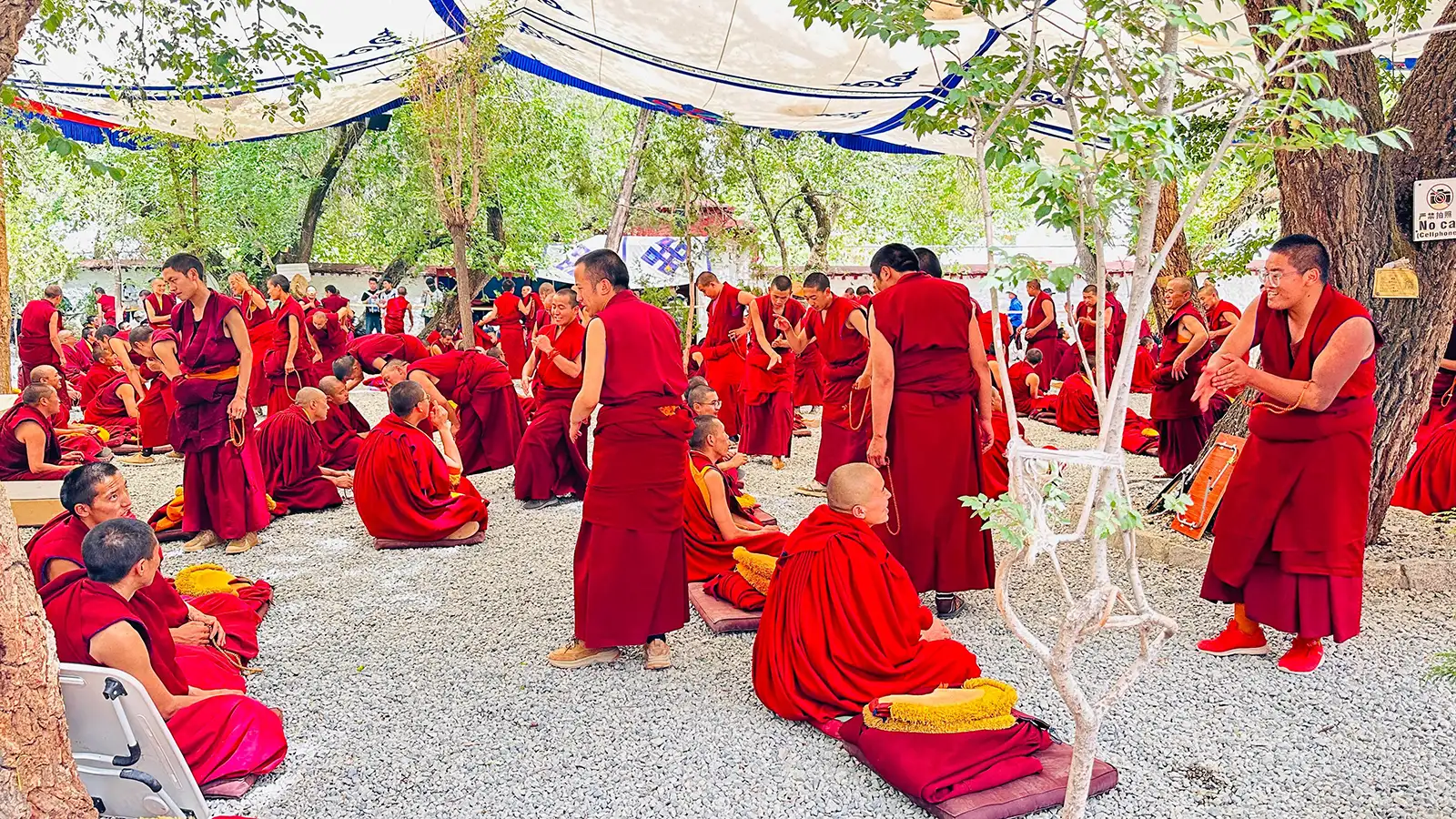
8. Bridging the Gap: Communication and Connectivity During Your Trip to Tibet
Staying connected with loved ones and navigating communication during your trip to Tibet can be a concern. This section provides essential information to keep you informed and to share your experiences.
Connecting to the World: Internet and Mobile Networks
- Limited Internet: Internet access in Tibet, especially outside major towns, can be limited and slow. Therefore, it is recommended that you download important information like maps and translations beforehand.
- Mobile Network Coverage: Mobile network coverage is improving in Tibet but might be patchy in remote areas.
Staying Connected: Keeping in Touch with Your Family
- Local SIM Card: Local SIM Card purchases are more reliable for mobile data and calls within Tibet. Trips to Tibet might offer guidance on this.
- International Roaming: Talk with your mobile service provider about international roaming rates, which can be expensive. If available, opt for Wi-Fi calling.
- Public Wi-Fi: Hotels, restaurants, and cafes in major towns often offer public Wi-Fi, but speeds vary. You must use a VPN for Google services like Google Maps, YouTube, Gmail, Facebook, Twitter, WhatsApp, Viber, etc. A paid VPN is recommended.
Language Considerations: Bridging the Gap
- Mandarin Chinese: While English is gaining some traction in tourist areas, Mandarin Chinese is the primary language in Tibet.
- Useful Phrases: Learning a few basic Mandarin phrases like “hello” (nǐ hǎo, 你好), “thank you” (xiè xie, 谢谢), and “please” (qǐng wèn, 请问) goes a long way.
- Translation Apps: Download a reliable translation app to help bridge the language gap with locals.
Remember: Communication can be a fun part of the cultural exchange during your trip to Tibet. Learning a few basic phrases and enjoying the unique cultural experience would be best.
9. Managing Your Expenses: Money and Budgeting for Your Trip to Tibet
A successful trip to Tibet requires planning your finances. This section offers valuable tips on currency exchange, budgeting, and avoiding scams, ensuring a smooth financial experience.
Understanding the Currency: The Tibetan Yuan
The official currency in Tibet is the Chinese Yuan (CNY), denoted by ¥. Note of 1, 5, 10, 20, 50, and 100 yuan, while coins come in 1 jiao (¥0.10) and five jiao (¥0.50) denominations.
Exchanging Your Cash:
- Before Your Trip: Exchange some cash for yuan before your departure, especially if you’re arriving outside major cities.
- Upon Arrival: Airports and major towns in Tibet have currency exchange offices.
Credit Cards and ATMs:
- Limited Acceptance: Credit cards are not widely accepted in Tibet, especially outside major towns. Rely primarily on cash.
- ATMs: ATMs are becoming more available in Lhasa and other large towns, but they might only work with some international cards. Check with your bank beforehand.
Budgeting for Your Trip:
- Costs to Consider: Factor in accommodation, transportation, food, entrance fees, guide fees (if applicable), and any planned activities.
- Tours vs. Independent Travel: Trips to Tibet can be more budget-friendly with a tour package that often includes many expenses.
- Daily Spending: Plan for a daily budget to cover meals, souvenirs, and miscellaneous expenses.
Avoiding Scams: Staying Financially Secure
- Beware of Overpriced Souvenirs: Haggling is common at markets, but be polite and respectful.
- Official Receipts: Always ask for receipts for any transactions.
- Double-Check Exchange Rates: Be aware of the current exchange rate to avoid getting ripped off.
Remember: By planning your budget and following these tips, you can manage your finances effectively during your trip to Tibet. Now, let’s explore some essential tips to make your adventure unforgettable!
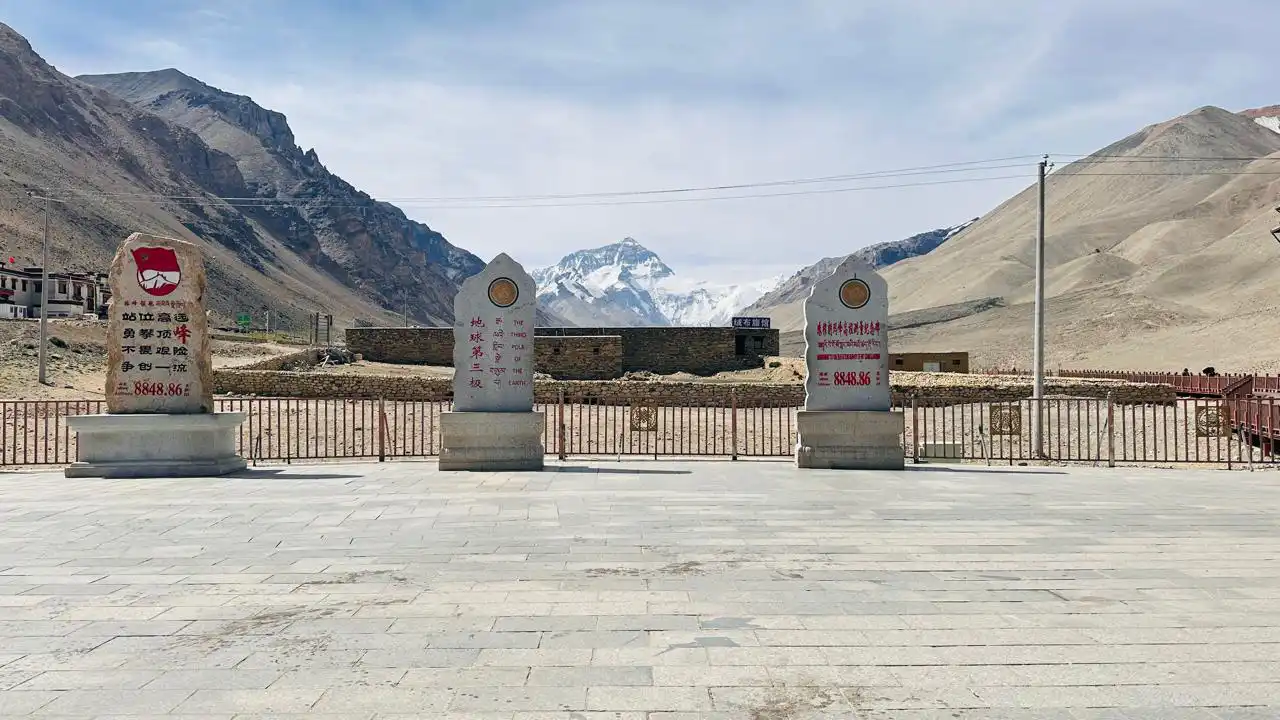
10. Unveiling the Magic: Must-See Attractions and Activities for Your Trip to Tibet
Tibet’s breathtaking landscapes and rich cultural heritage offer an unforgettable travel experience. This section explores the must-see attractions and activities, allowing you to amend the itinerary for your trip to Tibet.
Iconic Landmarks: Unveiling Tibet’s Grandeur
- Potala Palace: Potala Palace is the majestic former residence of the Dalai Lama, towering over Lhasa, is a UNESCO World Heritage Site and a must-visit.
- Jokhang Temple: This revered Buddhist temple in Lhasa is the spiritual center of Tibet and a pilgrimage destination for devotees.
- Sera Monastery: Witness the energetic chanting debates of monks at this sprawling monastery near Lhasa.
- Ganden Monastery: Perched atop a mountain, this serene monastery offers stunning panoramic views and a glimpse into monastic life.
- Yamdrok Yumtso Lake: 也被称为“碧玉湖” (Bì yù hú, meaning “Jade Lake”), this turquoise lake is a sacred site and a photographer’s paradise.
- Advanced Everest Base Camp: Kick off a challenging trek to witness the world’s tallest mountain from the base camp.
Crafting Your Adventure: Suggested Itineraries and Must-Do Experiences
- Cultural Immersion: Explore monasteries, witness prayer ceremonies, and interact with locals to experience Tibetan Buddhism firsthand.
- Trekking Adventures: Challenge yourself with treks to Everest Base Camp,に挑戦 (chōsen ni tatsu, meaning “challenge yourself”), explore glaciers, or hike through stunning valleys.
- Festival Fun: Time your trip to coincide with vibrant Tibetan festivals like Shoton (yogurt festival) or Garma Gyecé (horse racing festival).
- Wildlife Watching: Spot rare animals like yaks, kiangs, and Tibetan gazelles in the vast Tibetan wilderness.
- Geothermal Wonders: Witness the natural spectacle of hot springs like Yangpachen, located at a high altitude.
Remember: Tibet caters to various travel styles. Choose experiences that resonate with you and create a trip to Tibet that becomes a cherished memory.
11. Treading Lightly: Responsible Travel and Environmental Impact in Tibet
Traveling to Tibet allows you to experience a unique culture and breathtaking landscapes. But with tourism comes responsibility. This section highlights sustainable practices to minimize your environmental impact and support the region.
The Importance of Responsible Tourism
Tibet’s fragile ecosystem and rich cultural heritage require us to travel responsibly. Here’s why it matters:
- Preserving the Environment: Minimize waste, conserve water, and respect wildlife habitats to ensure Tibet’s beauty endures.
- Supporting Local Communities: Choose locally-owned accommodations and services and buy handicrafts directly from artisans, benefiting the Tibetan people.
- Protecting Cultural Heritage: Dress modestly at religious sites, open your sunglass cap, be careful about noise levels, and avoid taking artifacts to preserve Tibet’s unique culture, especially inside the monastery.
Minimizing Your Footprint: Eco-Friendly Practices
- Reduce Waste: Carry your water bottle, avoid plastics, and throw waste in bins.
- Respect Wildlife: Do not disturb their habitats, and never feed wild animals.
- Energy Conservation: Turn off electronic items like lights when not in use, and consider eco-friendly lodging options.
Supporting Local Communities and Conservation Efforts
- Choose Responsible Tour Operators: Opt for trips to Tibet that prioritize responsible tourism practices and support local communities.
- Support Conservation Efforts: Consider contributing to organizations working to protect Tibet’s environment and cultural heritage.
- Shop Local and Fair Trade: Look for handcrafted souvenirs made by local artisans and shops promoting fair trade practices.
Remember: Responsible travel is a journey of discovery and respect. By making informed choices, you can ensure a positive impact on Tibet’s environment and culture for generations to come.
Ready to start your unforgettable Tibetan adventure? Now that you’re equipped with essential information, you can plan a trip that’s as enriching for you as it is respectful for Tibet. Let the adventure begin!

12. Safety Net: Emergency Contacts and Support for Traveling to Tibet
Being prepared for emergencies is crucial for any trip, and traveling to Tibet is no exception. This section provides a list of important contact numbers and ideas to ensure a safe and secure adventure.
Essential Contacts: Having these numbers readily available is important:
- Emergency Services: Dial 110 for police and 120 for ambulance services.
- Lhasa Tourist Hotline: +86 891 6380 301 (English assistance might be limited).
- Nearest Chinese Embassy or Consulate: Locate the nearest embassy or consulate of your home country before your trip.
Hospitals: Major cities in Tibet have medical facilities. Here are some examples:
- People’s Hospital of Lhasa: +86 891 6380 5555
- First Affiliated Hospital of Tibet University: +86 891 6349 2222 (These hospitals might have limited English-speaking staff.)
Dealing with Emergencies: Staying Calm and Taking Action
- Remain Calm: In case of an emergency, stay calm and assess the situation clearly.
- Seek Help: Don’t hesitate to contact emergency services or your tour guide for assistance.
- Medical Attention: If medical attention is needed, proceed to the nearest hospital or clinic.
- Lost or Stolen Belongings: Report lost or stolen belongings to the police and your embassy or consulate.
Remember: By planning and having these emergency contacts handy, you can minimize stress and ensure a smooth resolution to any unexpected situations that might arise during your trip to Tibet.
Additional Tips:
- Register with Your Embassy: Consider registering with your home country’s embassy before your trip.
- Make Copies of Documents: Carry a passport copy, visa copy, travel insurance, itinerary, and other important documents. Please photocopy in black and white, not in color.
- Learn Basic Mandarin Phrases: A few basic Mandarin phrases can be helpful in emergencies.
With a little preparation and these resources at your fingertips, you can approach your Tibetan adventure with confidence!
Unveiling the Magic: Summary of Guide to Traveling to Tibet
Traveling to Tibet promises an adventure unlike any other. From the majestic peaks of the Himalayas to the vibrant culture and ancient monasteries, Tibet provides a window into a realm rich in tradition and stunning natural beauty. This comprehensive guide equips you with all the essential information to plan a smooth, enriching, and unforgettable trip.
Throughout this guide, we’ve explored:
- Cultural etiquette to ensure respectful interaction with the Tibetan people.
- Accommodation and food options to suit your preferences and budget.
- Transportation choices to navigate the vast landscapes of Tibet.
- Communication strategies to stay connected and bridge the language gap.
- Financial planning to manage your expenses effectively.
- Must-see attractions and activities to craft a personalized itinerary.
- Emergency contacts and support for a safe and secure journey.
A World Awaits: Explore Responsibly
Tibet’s unique culture and fragile ecosystem thrive on responsible tourism. Remember, trips to Tibet are a privilege, and mindful exploration is critical. Embrace the opportunity to learn, experience, and leave a positive footprint.
Final Tips for a Memorable Adventure
- Book in Advance: During peak season, flights, trains, and permits can fill up quickly. Plan and book well in advance, especially for tours to Tibet.
- Embrace the Altitude: Tibet’s high altitude can cause discomfort. Ascend gradually, stay hydrated, and be mindful of altitude sickness symptoms.
- Pack for All Weather: Tibetan weather can be unpredictable, so pack layers, sun protection, and sturdy shoes for diverse conditions.
- Be Open-Minded: Embrace cultural differences and immerse yourself in the unique Tibetan way of life.
- Respect the Local Pace: Life in Tibet moves at a slower pace. Relax, savor the moment, and appreciate the simple things.
With this knowledge and a sense of adventure, you’re prepared to start an unforgettable tour of the “Roof of the World.”

